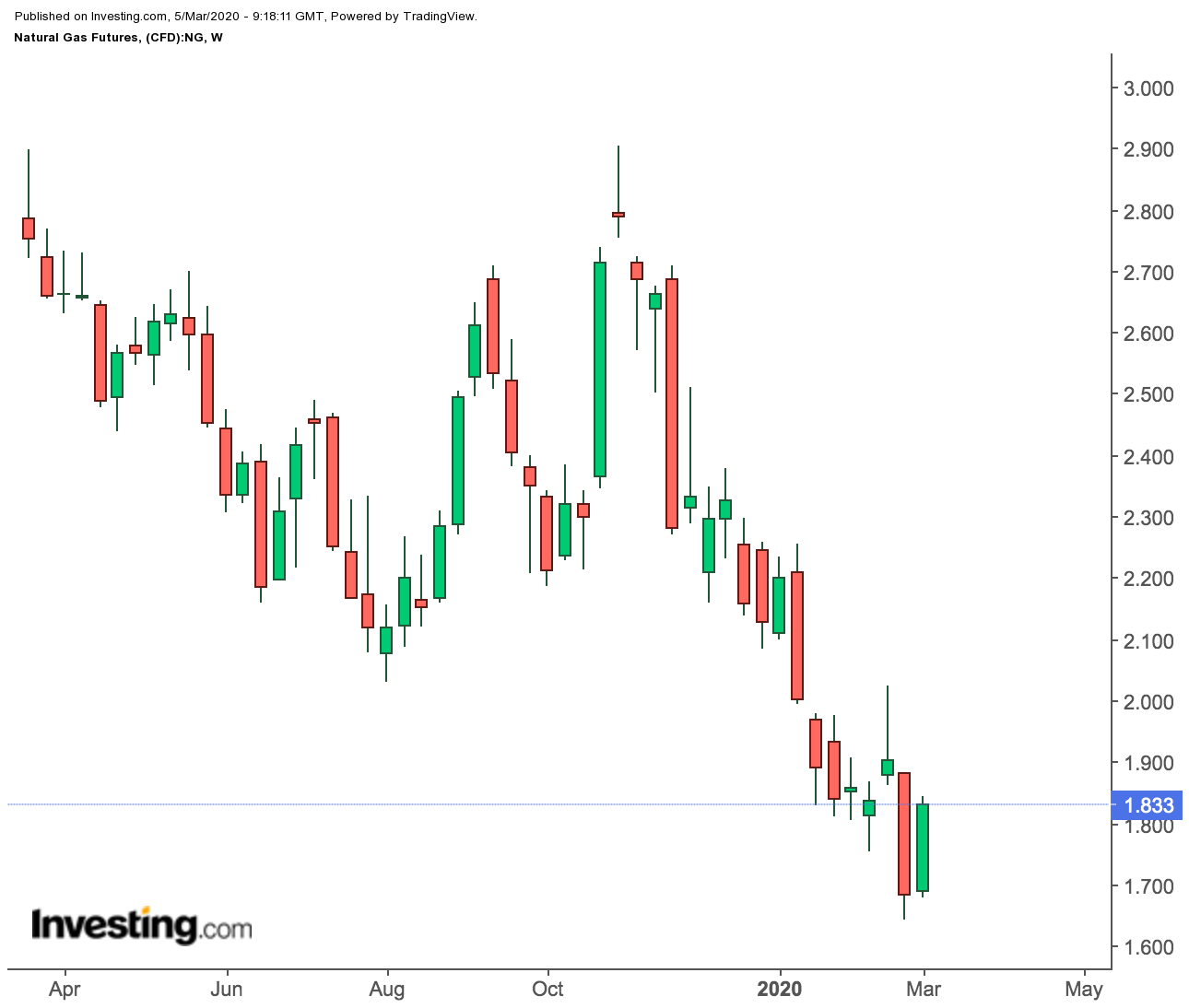“Low prices cure low prices” —or so the saying goes.
It’s an adage used to describe a market situation where prices of a commodity or product have fallen so much that its makers become discouraged to produce anymore. Continued consumption then tightens the supply, pushing prices back up.
Natural gas traders must have thought of this when prices of the fuel hit four-year lows last week.
In a rebound some are still trying to understand, the front-month April gas contract on the New York Mercantile Exchange’s Henry Hub took off the past three days, gaining more than 14 cents in all, after Friday’s trough of $1.642 for each million metric British thermal units (mmBtu).
Some Bet On More Short-Covering
A rally of nearly 9% in three days — or an average of 3% a day — normally doesn’t occur ahead of a week forecast to be one of the warmest for a winter. So, what’s happening here?
“For now, I would bet on higher prices rather than lower prices as the positioning is overly short,” said Scott Shelton, energy futures broker at ICAP in Durham, North Carolina. “I still think that a lot of the bearishness is priced in, and the macro could recover at some point this month.”
Despite record high gas production for months now — and projections that U.S. storage levels will end the 2019–20 winter heating season 12% above the previous five-year average — Shelton thinks the market’s fundamentals will improve over time.
This explains his bet: that the short sellers in Henry Hub futures will turn buyers at some point in the near future, or will at least cover at high prices when they get out of their short positions.
Others Say There’s An LNG Story Here
There’s another reason for Shelton’s conviction: liquefied natural gas, or LNG.
At some point, regardless of U.S. heating demand, Shelton thinks U.S. gas prices will do better because of LNG exports.
It’s a progressive thought not many have for gas despite the boom in U.S. LNG exports since they began four years ago, and the expected doubling of capacity at the nine domestic liquefaction trains for the fuel by the end of 2020. Said Shelton:
“I would argue that the tea leaves suggest that prices have adjusted to offset the amount of gas in storage due to lower supply and higher demand.”
“But the question lies in what will happen if the LNG export story becomes more bearish due to cargo cancellations and U.S. production rebounds. We can only wait for what power demand gains are going to be when demand is nil in the spring.”
All Eyes On Storage Numbers
This week’s rebound in gas prices came ahead of the U.S. Energy Information Administration’s regular gas storage report due at 10:30 AM ET (15:30) Thursday. The consensus of Investing.com’s analysts is that utilities across the country pulled 108 billion cubic feet from storage last week, versus the previous week’s drawdown of 143 bcf.
The weather last week was slightly warmer than normal for a final February week of weather.
Data showed there were 153 heating degree days last week, compared to the 30-year average of 161 HDDs for the period and 177 HDDs in the prior week ended Feb. 21. HDDs measure the number of degrees a day's average temperature is below 65 Fahrenheit (18 Celsius) and are used to estimate demand to heat homes and businesses.
Gas production in the U.S. Lower 48 states, meanwhile, averaged 94.08 bcf per day last week, marginally higher than the average of 93.73 bcf per day seen during the previous week to Feb. 21.
Warm Spell May End Rally
The warming trend makes some analysts, like Dan Myers of the Houston-based gas risk consultancy Gelber & Associates, skeptical of the market holding on to its recent gains.
In a note issued Wednesday, Myers noted that Henry’s Hub April benchmark contract was finding resistance at $1.83 per mmBtu.
“That’s a significant mark that’s both a 50% retracement of the last rally towards $2 and the current level of the 20-day moving average,” said Myers.
He added:
“Signals throughout the market continue to foreshadow another stab lower, with only a slight catalyst needed to trigger another round of selling.”
Last Big Drawdown?
Myers also thinks that Thursday’s storage numbers from the EIA will be the last in the current series to show a drawdown of 100 bcf or more.
“This is likely to be the last triple-digit pull of the season and withdrawals will get sequentially weaker as the winter season heads for an uninspiring end,” he said.
“As we get deeper into March, average seasonal temperatures warm quickly and decreases in heating demand could accelerate even faster this year when areas of the Midwest and East get an early taste of spring.”
Myers’ skepticism is shared by Dominick Chirichella, director of risk and trading at New York’s Energy Management Institute, who anticipates significantly mild weather to possibly even heat in the coming days.
According to Chirichella, heavy rain and severe storms remain a threat from Thursday near the Gulf Coast and Southeast Coast.
Widespread above-normal temperatures were expected to occur across the Central/Eastern U.S. over the next two weeks, he said.
The warmest anomalies should be across the North Central and Northeastern U.S., Chirichella said.
He added:
“Demand will be below normal over most of this period guaranteeing inventories will end the official winter heating season at above normal levels. I remain bearish and expect the current uptick in prices to not last very long.”
